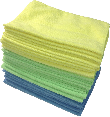Using White Vinegar to Clean
Written by Lee Wyatt (last updated July 31, 2023)
Not only is white vinegar an amazingly inexpensive item, it is particularly effective as a cleaner. This common household ingredient can actually be used to clean just about anything that you can imagine. There are so many different cleaning uses for white vinegar that the information could literally fill up a book. However, here are a few of the more common methods that you can use white vinegar for. While there may be a few additional ingredients to some of these methods, the main ingredient will almost always be white vinegar.
- Freshening up a sink. White vinegar can be used to freshen up a sink in a variety of ways. For example, if you have a stinky drain pour roughly 1/2 cup of baking soda down it, followed by two cups of white vinegar. Allow the mixture to sit and bubble for no less than five minutes before you begin to flush the drain. For a dirty aerator simply drop it into a cup of heated vinegar. This will help remove any hard water deposits that have built up over time.
- Counteract cooking odors. One of the biggest problems in the kitchen is probably odors that have a tendency to linger long past their time. Some examples of this fish, cabbage, onions, and so on can all be removed or counteracted by using some white vinegar. Simply boil a mixture of water and vinegar for about ten minutes. The ratio of the mixture should be two tablespoons of vinegar for every cup of water.
- Window cleaners. A very effective window and glass cleaner can be made from white vinegar and water. Simply mix together a solution of 50/50 water and vinegar and pour it into a spray bottle. Spritz the mixture onto the dirty glass or mirror, and then wipe away with some paper towels or newspaper. When you are finished, everything will be sparkling clean.
- Clean coffeemakers. You can get a coffee cleaner clean, from the inside out, by simply filling up the water reservoir with full strength white vinegar. Run the vinegar through a complete brewing cycle, and then repeat. Halfway through the second time, turn the coffee maker off and allow it to sit for between 15 and 20 minutes. While the coffee maker is sitting, use a little bit of the window cleaner solution that you created earlier, and clean off the outside of the coffee maker and carafe. After the time has passed, turn the coffee maker back on for the rest of the brewing cycle. Run at least one cycle of water through a brewing cycle before brewing any coffee to remove the taste and smell of vinegar.
Author Bio
Lee Wyatt
Contributor of numerous Tips.Net articles, Lee Wyatt is quickly becoming a regular "Jack of all trades." He is currently an independent contractor specializing in writing and editing. Contact him today for all of your writing and editing needs! Click here to contact. Learn more about Lee...
Finding Space for a Home Office
If you have ever had trouble finding space for a home office before, then take a look here. These are some simple ...
Discover More
Prepping Walls for Painting
Before you can get that old and tired looking room to back to its best, you need to get it ready for painting. Luckily, ...
Discover More
Removing Paint from Tile
Removing paint from tile, while frustrating, is entirely possible. All you need to do is know how, and apply a little bit ...
Discover More
Household Cleaners
There are a lot of household cleaners out there. This article focuses on the most common ones.
Discover More
The Top Five Household Cleaners
Instead of trying to buy a different specialized cleaner for each surface in your house, you can make many of your own ...
Discover More
Make Steel Wool Go Further
Steel wool, a combination of fine steel and soap, is a great tool for scrubbing stubborn messes off of dishes and other ...
Discover More

Comments